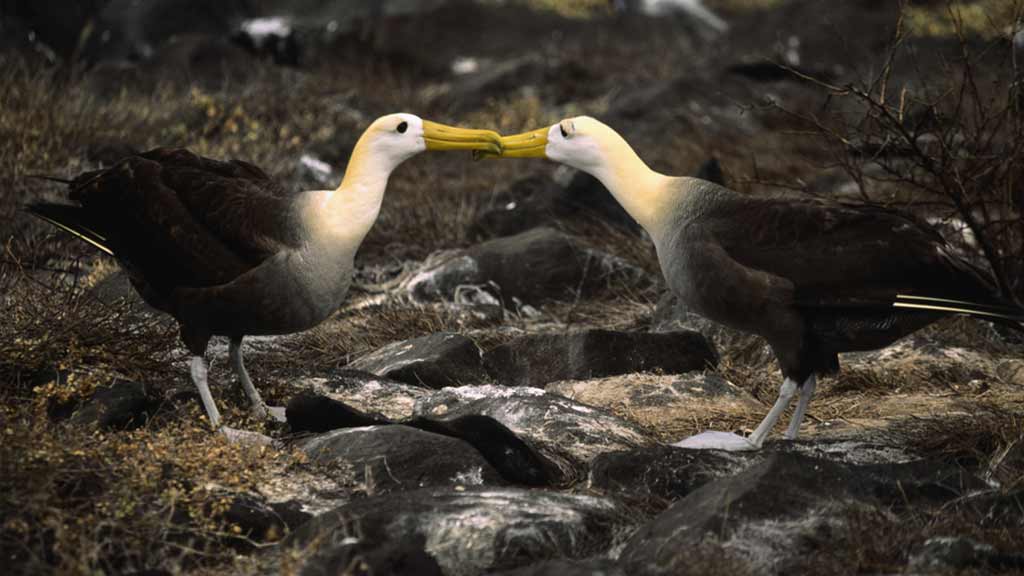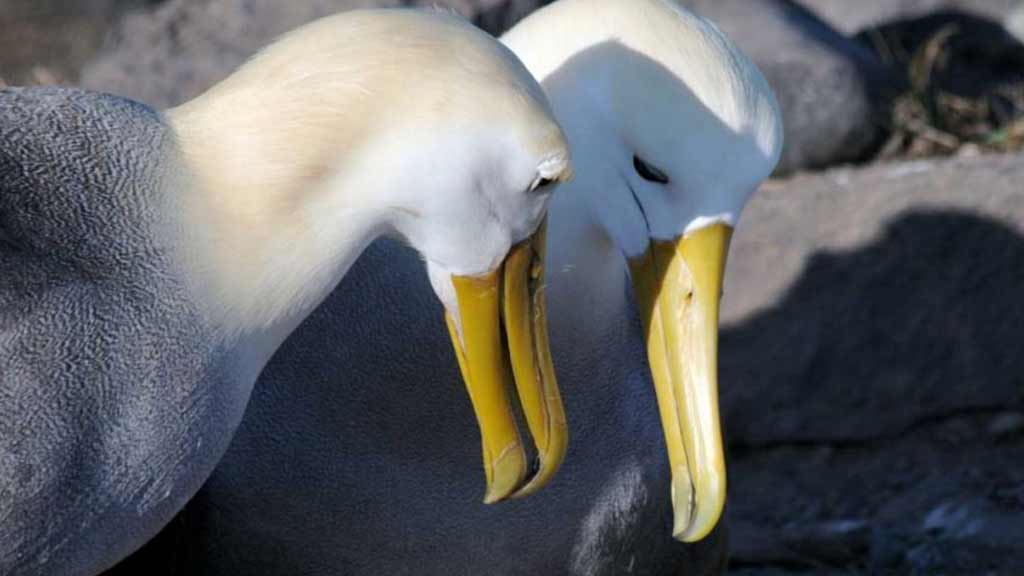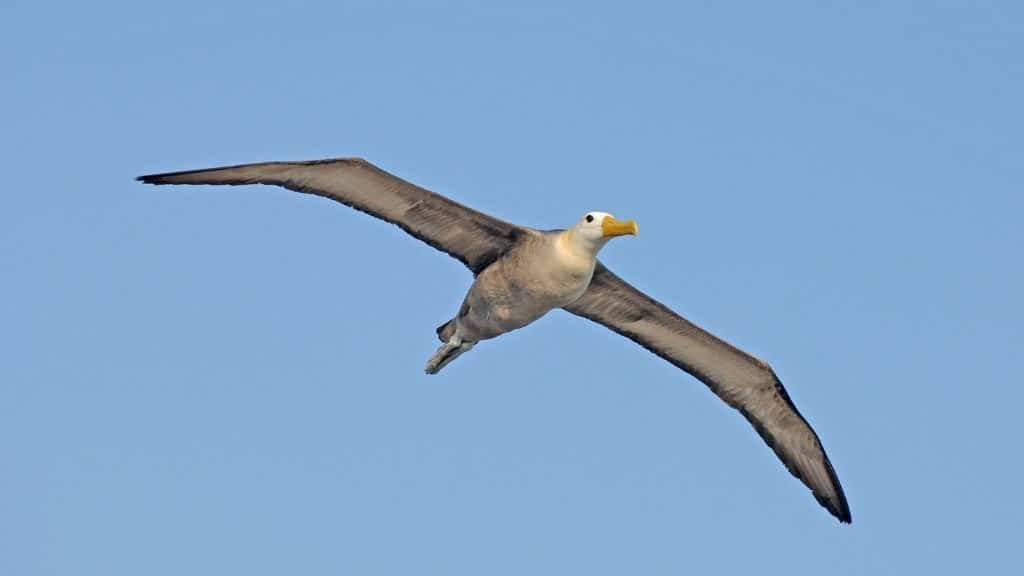GALAPAGOS ALBATROSS (Waved Albatross)
The Galapagos Albatross is the largest and most graceful of all Galapagos birds, and without doubt a favorite for many visitors. Breeding at only place on the planet, the Galapagos albatross spends nine months each year on Española island. Be sure to travel during these months to see them – the Waved albatross is a Galapagos highlight that you won’t want to miss!
Keep reading to learn more about the majestic Galapagos Waved Albatross. We'll cover everything from when and where to see them, to fun Galapagos Albatross facts and trivia.
Scientific Name: Phoebastria Irrorata
Conservation Status: Critically Endangered
Endemic Status: Breeding Endemic Galapagos Species
How to See a Waved Albatross at Galapagos?
The instructions to see a Waved Albatross at the Galapagos Islands are very simple: Take a cruise that visits Punta Suarez on Española Island between the months of April and December. There you will find a large waved albatross colony performing courtship dances and nesting.
WHERE to See the Galapagos Albatross?
The only breeding waved albatross colony on the planet is found at Punta Suarez on Española Island in Galapagos. This is a regular stop on the Galapagos cruise circuit, as well as an occasional day trip destination from San Cristobal. Punta Suarez is one of the best very Galapagos visitor sites for bird watchers, with large seabird colonies of Blue footed boobies, Nazca boobies, and of course Galapagos Albatross. This spot makes an ideal home for the waved albatross colony, where they find flat terrain for nesting, clifftop protection, and strong winds for easier takeoff.
After disembarking at Punta Suarez, a rocky path leads excited visitors right into the heart of the Galapagos Islands albatross colony, for an unbeatable close-up encounter. Observation of Galapagos albatross nesting behavior is fascinating, with adults caring for their cute hatchlings, and endearingly tender interactions between family members. These are extremely beautiful and elegant birds to observe.
You can also witness waved albatrosses flying high in the air currents around Punta Suarez, and sometimes at other parts of the Galapagos Marine Reserve too.
WHEN to see Galapagos Albatross at Española?
Albatrosses can be spotted on the Galapagos Islands from April through to December when they come to nest and breed. Timing is important for an albatross family – Galapagos seas are colder from the month of May to the end of the year. A colder ocean is more nutrient-rich, ensuring that newborn albatross hatchlings will be well-fed.
Once Galapagos Albatross hatchlings become fledglings, they must leave the islands by mid-January or sooner, while the winds are still strong enough for their take-off. Where do the Galapagos albatross go between December/January and March? They head out to feed in the open ocean, usually to the eastern waters of Galapagos, and the coasts of Ecuador, Colombia, and Peru.
Like clockwork, adults return again to Española island the following April to repeat their breeding cycle. Meanwhile, young waved albatross remain in the ocean for several years until they themselves are ready to find a mate.
Contact us for a FREE GALAPAGOS TOUR QUOTE with no obligations, or for more information about how to plan your vacation at the Galapagos Islands to see Galapagos albatross.
Everything You Need To Know About The Galapagos Islands Albatross
Galapagos Waved Albatross Appearance
The Galapagos Albatross is easy to distinguish from other birds on the islands due to their large size. An adult waved albatross can grow to over 90cm in length, and weigh 3-4kg, which is very large for a seabird. Albatross wingspan is also impressive, clocking in at an average of 2.2 meters.
In terms of appearance, the Galapagos albatross is a very attractive and elegant bird. Both albatross sexes have a white head with cream-colored crown and neck, chestnut brown bodies with waved patterns (hence their name), and yellow beaks.
Galapagos Albatross Behavior
It is the typical behavior of the Galapagos Albatross that makes them so endearing to visitors. Their courting behavior is almost alike to humans and seems rather romantic. Waved Albatross courtship can last up to two years, which makes good sense when preparing to spend nearly three decades together. The tenderness between albatross couples is particularly heartwarming, as they touch beaks as humans would hold hands.
The ritual of the Waved Albatross mating dance is not to be missed. Couples perform an elaborate dance together, complete with circling and clacking of bills, head nodding, and waddling. A successful albatross couple will lay and rear a single egg between April and June, to be incubated for two months. Then follows a nursery period when proud Galapagos Albatross parents forage for food for their chicks. Young must be fattened up and ready to leave the Galapagos Islands in December. Around mid-January the Galapagos winds die down, so any albatross still found on Española at that time will be left stranded, unable to take off.
Few birds in the world are as majestic in the air as a waved albatross! Making good use of their mighty wingspan, they are highly skilled flyers, gliding effortlessly on air currents. They spend long periods of their lives above the open ocean foraging for food, only heading to land for nesting & mating.
Waved Albatross Diet
The Galapagos Albatross feeds on fish and squid, hunting at night when their prey is close to the surface of the ocean. They may also scavenge from nearby fishing boats, or even steal food from other Galapagos bird species like boobies. During mating season, adults take turns to hunt, returning to the nest to regurgitate food for their young. Hatchlings can fly and hunt for themselves after 5 and 1/2 months or so of adult care.
Galapagos Albatross Conservation
Galapagos waved albatrosses are on the critically endangered list, with only 12,000 breeding pairs in the world today. Why is the waved albatross endangered? In truth, they are not helped by their own overreliance on a single nesting place. This puts them at potential risk of changes in climate or habitat, such as the El Niño phenomenon. Invasive species also cause problems for albatross nests in Galapagos. Goats had to be eradicated from Española, for example, to remove the risk of trampled albatross nesting sites.
Other conservation threats for Galapagos albatross come from long-line fishing practices. Albatrosses are attracted to long-line baited hooks, and frequently drown if they become trapped. Fortunately, long-lining is banned within the Galapagos Marine Reserve, but albatross are at risk as soon as they leave these protected waters.
Plastic waste is another big issue facing many Galapagos species, including the albatross. Plastics in the sea are easily confused for squid and cause serious problems or death once ingested. Happy Gringo proudly supports the Plastic Free Galapagos campaign, which we urge visitors to learn more about. We donate a reusable water bottle (with a beautiful wildlife design) to our Galapagos land tour passengers. This prevents the need to buy plastic water bottles each day of your trip.
Interesting Galapagos Albatross Facts
• The waved Albatross is a monogamous species. After selecting their partner, a Galapagos Albatross will mate for life. The couple stays together until one or the other dies.
• While graceful in the air, the Galapagos Albatross is rather clumsy on land. Tourists are often amazed by their bungling, hair-raising take-offs & heavy-handed crash landings.
• When young Galapagos albatross wave goodbye to the islands for the first time, they usually won’t return to Galapagos for several years (up to 6). They spend their early, formative years out to sea. Only after reaching breeding age do they return to Española island to find a mate.
• Studies show that an adult albatross could circle the globe in just 46 days, that’s almost 5 weeks faster than Phileus Fogg!
If you enjoyed reading our Galapagos Waved albatross facts, then check out more fascinating information about Galapagos Bird Species.
The Galapagos Albatross is without a doubt one of the most majestic birds in the archipelago. Whether flying gracefully across blue Galapagos skies or courting one another tenderly on land, they never fail to endear themselves. Even when clumsily crash landing, the waved albatross somehow recovers their dignity, forever one of the most popular creatures for Galapagos tourists. The Waved Albatross is a must-see species for your Galapagos vacation!




